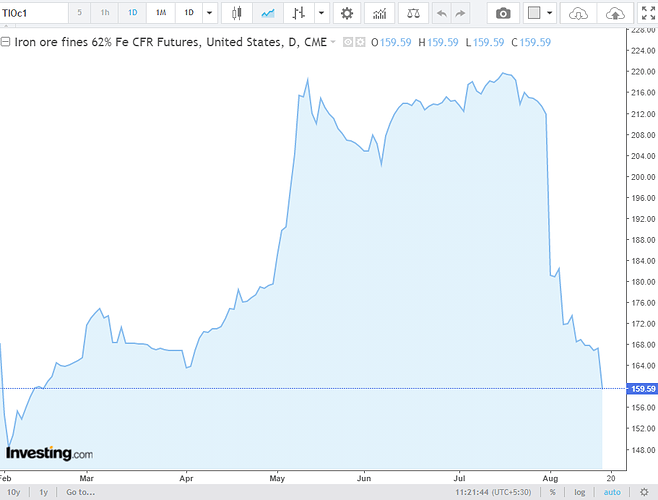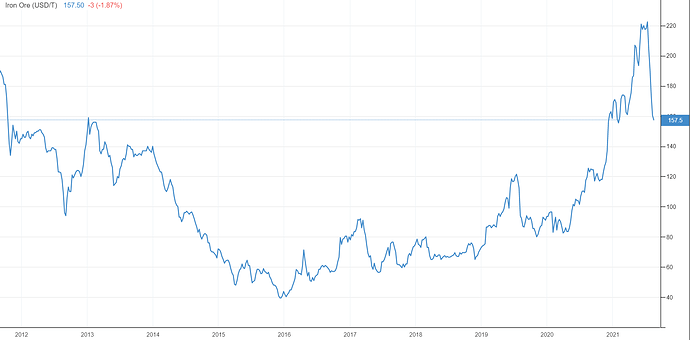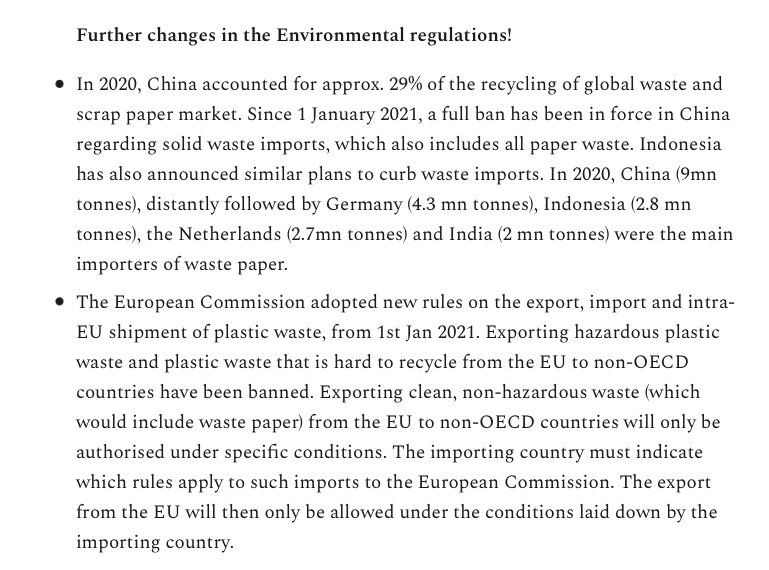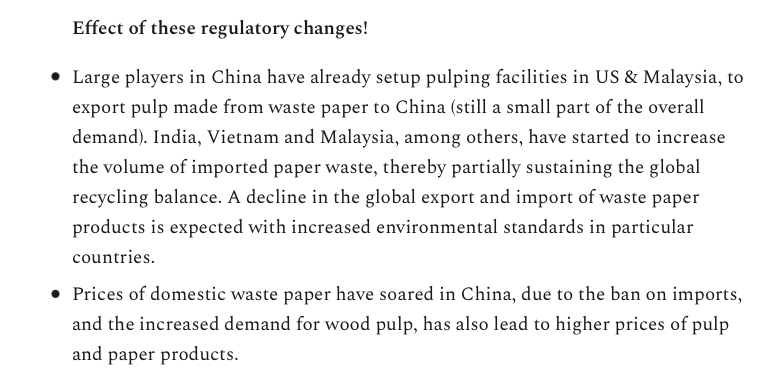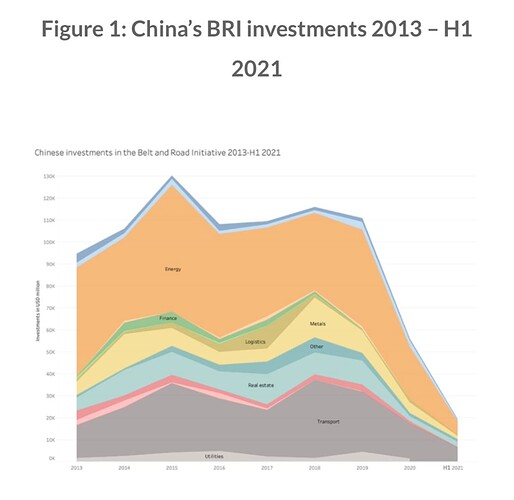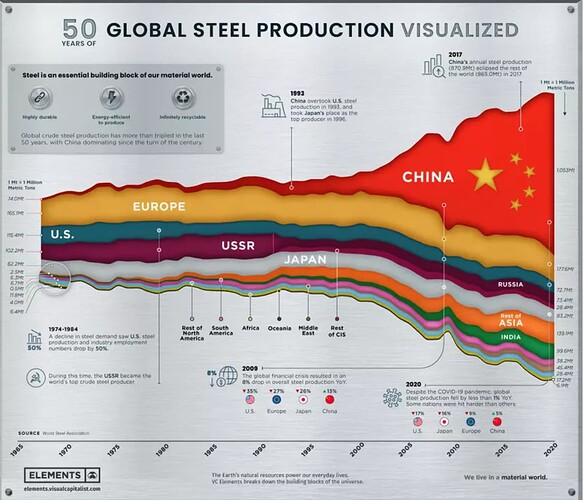Not sure actually. New capacity is due anytime now. Management generally comes on CNBC TV 18 post results. Will wait for interview.
Capital Goods - Sector seems to be coming out from multi-year slowdown. If a strong recovery happens, companies in this sector will have dual benefit of higher revenue and improved margins due to operating leverage.
Apart from decent financial performance during Jun-21 quarter, comments on order inflows in recent investor releases by few leading capital goods companies are strong:
Siemens
• All business segments record New Order growth over pre-pandemic 2019 levels.
• Highest Order Backlog ever
• Increased demand for digital technologies, including cybersecurity solutions
ABB
• Orders up 41% for the quarter and 11% for H1 Y-o-Y
CG Power
• Industrials - Order Intake for the quarter were higher at Rs 1058 crores recording a growth of 30% QoQ. Unexecuted Order book at the end of Jun 2021 was Rs 1691 crores
• Power systems - Order Intake for the quarter were higher at Rs 433 crores recording a growth of 22% QoQ. Unexecuted Order book at the end of Jun 2021 was Rs 1197 crores
Coal has turned out to be the unlikely winner until now in CY21 rising 83%. Coal India is on verge of start of coal price upcycle, management expects e-auction premium to jump to 50-75% from Q1 avg of 12%. Every 10% jump in e-auction premium is 12% increase in Coal India’s EBITDA.
Source: It's ugly, dirty and unloved but churning cash...
Not entirely sure if this belongs to this thread, but a good take by ET Prime on future ethanol blending (affecting the likes of Praj etc):
Quote from the article:
However, the road to higher ethanol blending isn’t going to be smooth. The future of higher ethanol blending percentage also depends on how quickly the automobile industry makes E10 and E20 compliant vehicles. Vehicle designs will have to be made after considering material compatibility and engine tuning and optimisation in order to benefit from ethanol blending.
Then there is the issue of impact of high ethanol prices on fuel. “Right now, the blending percentage is 7%-8%. At this level, there is little or no impact of lucrative ethanol prices on the end-product (fuel). But by the time blending reaches 20% or even up to l00% use of ethanol with flexi-fuel vehicles, the government will consider different ways to make ethanol more attractive and commercially viable renewable fuel,” says Suryavanshi of PhillipCapital.
New RODTEP Policy by Government of India to boose Export from India. This scheme is applicable from 01-01-2021 period.
replaces MEIS / RoSCTL, not a gamechanger.
https://taxindiaonline.com/RC2/inside2.php3?filename=bnews_detail.php3&newsid=37272
Interesting. Is there a site where you can get these details for other stocks?
Have taken a slightly longer perspective, looks like iron ore is quite volatile as we can see here
There is a close correlation with steel prices
Understanding the Steel Industry Chain
Found so much information on pharma and other industries and not so much on steel industry, spent some to understand the value chain from basic. Feel free to flag if the content is not relevant, I will not hesitate deleting this post.
Analysis of the upstream, midstream and downstream markets of steel industry chain (with a panoramic view of the industry chain)
Steel consumption directly contributes to Indian economy. This important material is also necessary for construction and development of residential house, infrastructure and others. It is widely used and has a wide variety of applications.
Industry chain: Upstream is steel billet processing; the midstream is steel manufacturing mainly divided into general steel, stainless steel, special steel and metal products; the downstream is the application of steel, which is mainly used for real estate construction, infrastructure construction, etc.
Upstream analysis:
- Pig iron: Iron ore is smelted in a blast furnace (BF) to form pig iron. Different forms of carbon in pig iron, it can be divided into steel-making pig iron and cast pig iron. The properties of pig iron are hard, wear-resistant and good castability, but pig iron is brittle and cannot be forged. Pig iron is an iron-carbon alloy with a carbon content of more than 2 percent. Industrial pig iron generally has a carbon content of 2.11 – 4.3 percent and contains elements such as Si, Mn, S and P
Scrapped steel is also smelted in BF
Vedanta’s Sesa Goa is the leader, from more details about pig iron Pig Iron Specification - Sesa goa iron ore
Raw material: Ore, coke, limestone
BF maintenance mostly involves re-lining with blast furnace bricks which don’t melt at high temparatures - Crude steel: Crude steel refers to the coarser steel, which is the finished product after the molten iron is processed, alloy, carbon and other elements are cast and formed, and it refers to the final raw material for steel processing. Its main purpose is to be used as raw materials to make various specifications of billets, plates, pipes, steel bars, wires, castings, etc. Its performance is determined by the alloying elements contained in the steel and the manufacturing process. United States use crude steel weight to calculate country’s steel output, India stands next to China in steel production
Ladle furnace with graphite electrodes (consumables) are used in this process - Steel slag: Steel slag is a kind of waste created during the process of smelted steel in blast furnace. Impurities formed during the making of crude steel. Harsco is a global leader in metal recovery from steel slag.
In developed countries slag coming out of BF is commercially used in Cement industry, Indian ministry of steel is working with various agencies to commercially exploit this material. Tata steel launched LD slag products for application in roads, fly ash bricks and clinker making
Downstream analysis: High value add in steel happens closest to the applications. Pipe fittings (taps, showers), lock products, automobile components, electric applications, construction machinery, locomotives etc. Few specific applications like high end manufacturing industries like aerospace, turbines, tools, dies, moulds and others have specific needs and this category is called special steels. India has limited capability in manufacturing high end steel, an area to watch for
Midstream analysis: Operations that are often taken to include some elements of the upstream and downstream. Products here include hot and cold rolled steel coils, steel bars, wire coils, and bar steel coils; in terms of stainless steel, there are cold and hot rolled stainless steel coils, stainless steel rods and wires, and stainless-steel sections. And the cutting and processing and pipe making industry in the subsequent period. Using general steel billet as raw material, it is rolled into coils, which can be processed to produce downstream products such as screws, nuts, steel wires, etc.; the difference between wire coils and bar steel coils in the middle reaches, the diameter of which is greater than 14mm, is called Bar steel, the one below 14mm is called wire. More than 60 percent of steel manufactured goes for construction.
Borrowed some stuff from the below link and majority of the stuff was collated from different websites
Understanding the Steel Industry Chain | Market Prospects (market-prospects.com)
IMO, cyclicality elements of steel industry is low in companies that deal with downstream industries, identifying and investing in these companies might create wealth
Disc: Holding Sandur Manganese & Iron ore and JSW steel, not a recommendation
Another really cool presentation from Kenneth. This is the first time I have seen someone comparing EBITDA/ton of a steel company with EBITDA/car for a consumer company.
Today Shanghai market steel stocks went up
Industry Details - Steel - Materials (aastocks.com)
Is anybody tracking PLI scheme for specialty steel, did not see any progress. Was going through the annual reports and found, the focus is on specialty steel
| RANK | COMPANY | Head quarters | million ton 2020 | Reports |
|---|---|---|---|---|
| 1 | China Baowu Group | China | 115.29 | 2021042300905.pdf (hkexnews.hk) |
| 2 | ArcelorMittal | Luxembourg | 78.46 | MT- 31.12.2020 - 20-F Document (arcelormittal.com) |
| 3 | HBIS Group | China | 43.76 | HBIS Group Company Profile, News, Rankings |
| 4 | Shagang Group | China | 41.59 | 北京首钢股份有限公司2020年年度报告全文 (shougang.com.cn) |
| 5 | Nippon Steel Corporation | Japan | 41.58 | Investor Relations |
Agree with your thesis.
In addition to this, a couple of new developments have taken place-
Note- Pics are from my write up- https://valueortrap.substack.com/p/andhra-paper
(Disc- Invested. )
Source- Paper Makers Hike Prices Ahead of Chinese Ban on Solid Waste Imports
https://www.thehindubusinessline.com/markets/commodities/how-the-...industry-has-been-affected-by-the-3-c-factors/article34131826.ece
Home || The Pulp and Paper Times
I can understand share market rout of Vedanta, NMDC but couldn’t get my head around the sharp fall in Tata Steel, JSW shares. Any output cuts in China is positive for Indian steel companies, right? Or am I missing something?
China’s ( largest consumer and producer of commodities ) appetite for Mega investment is going down
Look at BRI investment It has collapsed dramatically in post COVID world where in most emerging countries where China was doing these investments cannot pay back …
This has huge impact on usage demand for commodities ( other than because of supply chain dislocations & to fill up inventories that has been disturbed because of COVID restrictions )
To add to woes … China has been over producing steel …
This is not helping if China plans to reduce BRI and local infra investment … There is no need for China to have 50% of world capacities if it is moving to maintenance infra mode … Look at steel production of Europe and USA once the completed rebuilding themselves post WW 2 destruction
China will have to reduce capacities by nearly 1/3 in long run … while India may have to increase capacities … But that process will not be easy …
India is currently producing more steel than it is requires … but quality wise this equation is even more skewed and India still imports high grade steel while over produces low grade steel … It needs to balance quality and quantity of production ++ needs government support to prevent imports in big way from others countries esp in high grade steel …
These all are long term trends but in short term supply dislocation because of shipping bottlenecks and COVID will dominate price actions
Views of @Rakesh_Arora sahab and @kb_snn sahab seems contradictory. If China is slowing down and hence decrease in its consumption it could lead to 2015 situation where China dumped steel all around the world causing price to collapse. But if china is decreasing its output in tandem with consumption then would keep steel prices firm.It should also be net postive for Indian steel players in short run and long term.
Hence , Indian steel companies should attract higher PE ratio because its share is only going to increase like what happened in API sector.
Reduction by China may not be due to poor demand. It seems that they are forced to cut production due to pollution norms… any production cut by China is a win win situation for India.
Other factor which is affecting steel price in India is the new iron ore mining policy… Govt wants more share in Iron ore mining. New auctions are getting costlier and costlier. It is difficult to produce iron ore at cheaper rate now… Many companies who won the Iron ore mines in auction were unable to start mining as it was not profitable for them. High Iron ore price likely to keep the steel price higher only. Those who are having captive mines will be having advantage…



